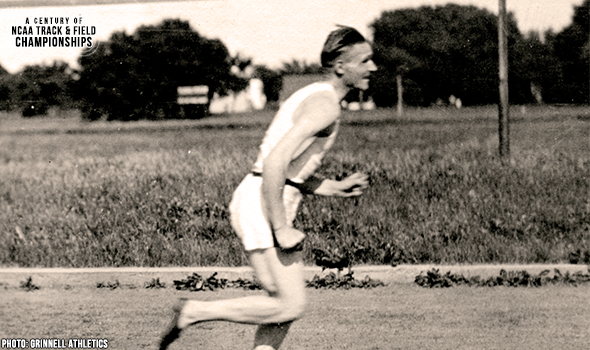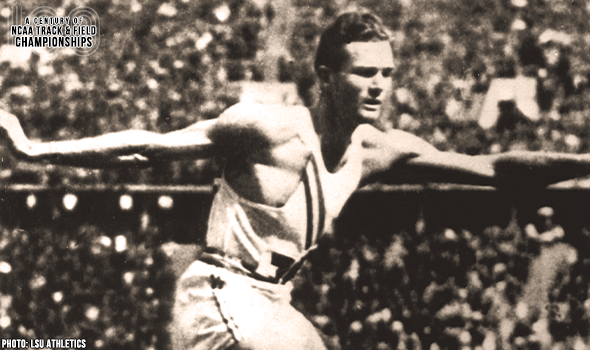
Brooks Made NCAA Shot Put History
In the span of five years, Tia Brooks went from a prep athlete at East Kentwood (Mich.) High School fighting tooth-and-nail to never throw the shot or disc to a college freshman at the University of Oklahoma battling exponentially harder for the smallest possibility of being able to launch her prized weighted orb just once more after suffering a near career-ending injury.
Perspective has an interesting way of changing things.
“I didn’t want to be the stereotypical thrower – the big girl who didn’t run and wasn’t athletic,” Brooks later told the State Games of Michigan website. “But when I realized that I can maintain my femininity and just get stronger and make strong look beautiful – it’s kind of empowering.”
After a standout prep career where she was a state champion, a two-time regional champion and a four-time all-state honoree, Brooks earned a scholarship to compete for the Sooners. But, not long into her freshman year at Oklahoma, Brooks lost feeling in her legs during a weightlifting session and had to be stretchered out. It was later discovered that Brooks had two bulging discs, a degenerative disc disorder and a narrowing of her spine.
Doctors recommended that Brooks should quit throwing and focus on another sport, yet the Michigan native wasn’t deterred. She vowed to push through her rehab with just as much tenacity as she would in the circle during a competition – and before long, she returned.
After moderate success as a redshirt freshman (runner-up finishes at both the Big 12 Indoor and Outdoor Championships), Brooks had a breakthrough year in 2011. The sophomore won the Big 12 indoor title and finished runner-up at both the NCAA Indoor and Outdoor Championships.
To say Brooks turned it up a notch as a junior and senior would be an understatement. She went a combined 17-3 in shot put finals in her final two years with the Sooners – including a perfect 8-0 mark in championship settings between both sets of Big 12 and NCAA meets to sweep each title twice – and left her name all over the collegiate indoor and outdoor record books.
Brooks, though, saved her best for last. After a junior year where she won both NCAA titles by more than two feet and finished third at the U.S. Olympic Trials, Brooks broke the collegiate indoor record at the 2013 NCAA Division I Indoor Track & Field Championships with her winning heave of 19.22m (63-0¾) and then shattered the 15-year-old meet record at NCAA Outdoor Championships by nearly one foot at 18.91m (62-0½). Brooks’ best outdoor mark in 2013 came at the NCAA Division I First Round Championships when she landed the orb just three centimeters (1½ inches) behind Meg Ritchie’s long-standing collegiate record.
“People are not often born with the desire to shot put,” Brooks later told the State Games of Michigan website. “Instead, they progress into the sport. Therefore, it is important to realize that as long as you maintain your athleticism, you can be successful in a variety of sports. I was pretty resistant to being a shot putter, but when I gave it a try, I knew it was my calling.”
The NCAA and collegiate track & field will mark a momentous milestone in the spring of 2021 -- the 100th anniversary of the NCAA Championships and with that, the NCAA Track & Field Championships. In June 1921, the University of Chicago hosted the first track & field championships in NCAA history.
This point can’t be emphasized enough: Not only was the event the first for NCAA track & field, but the first championships for any sport under the sponsorship of the NCAA.
To celebrate, over each of the next 365 days, the U.S. Track & Field and Cross Country Coaches Association (USTFCCCA) will celebrate moments, student-athletes, and coaches that have made a century’s worth of championships special. From humble beginnings to important historical milestones to the modern-day, collegiate track & field has evolved with the American society.
The 2021 edition of the NCAA Division I Outdoor Track & Field Championships begin with preliminary round action on May 27-29 in Jacksonville, Fla., and College Station, Texas. The championships final site and culmination of the celebration is slated for June 9-12, 2021 at the newly rebuilt Hayward Field in Eugene, Ore.

SIU’s Roggy Dominated The Javelin In 1978
Bob Roggy won the javelin title at the 1978 NCAA DI Outdoor T&F Championships by more than 20 feet. Roggy qualified first for the final with a MR heave of 89.30m (293‑0).

Makusha Made History In Bowerman Year Of 2011
Ngoni Makusha became just the fourth man in meet history to win individual titles in both the 100 and LJ. It was his 3rd career LJ crown and he set a CR in the 100 of 9.89.

George Mason’s Gage Shocked The NCAA LJ In 1988
Nena Gage won the long jump at the 1988 NCAA DI Outdoor T&F Championships in a shocking upset over Gail Devers.

Texas’ Thompson Marveled In NCAA Distance Events
Jerry Thompson won three career distance titles at the NCAA Outdoor T&F Championships. His first came in 1943. Then he won again in 1947 & 1948 after serving in World War II.

Grinnell’s Paulu Sprinted To NCAA History
Leonard Paulu was the first athlete to complete the 100-200 double in NCAA Outdoor Track & Field Championships history in 1922. That also made him the 1st to win back-to-back 100 titles, too.

Scott Won Back-To-Back NCAA Hammer Titles
Candice Scott won back-to-back hammer throw titles at the NCAA DI Outdoor T&F Championships in 2003 & 2004. Scott set a meet record of 69.77m (228-11) in that first year.

Drouin Soared To The Bowerman In 2013
Derek Drouin won two career HJ titles at the NCAA DI Outdoor T&F Championships. When Drouin won in 2013, he was only the fourth man to clear 2.34m (7-8) in meet history.

Watts Made Quick Work Of NCAA 400
Quincy Watts set a meet record in the 400 of 44.00 at the 1992 NCAA DI Outdoor Track & Field Championships. It lasted 25 years until 2017.

Iowa State’s Koll Rolled To 5K-10K Crowns
Lisa Koll won three career titles at the NCAA DI Outdoor T&F Championships in dominant fashion. Her average margin of victory in those 5K & 10K races was 37.73 seconds.

LSU’s Hardin Completed Unique 440-220H Double Twice
The nearly unheard of 440-220H double was so nice that Glenn Hardin did it twice! Hardin became the first to do so in meet history in 1933 and then swept them again in 1934.

